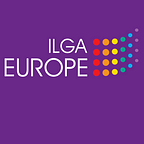6 Ways Forward for LGBTI Organisations to be Inclusive of People With Disabilities
BeLonG To, the leading Irish organisation for LGBT young people is on the vanguard of working on the instersection of LGBTI and disability. Here we share their journey so far, and some great tips for for LGBTI organisations who want to be inclusive of people with disabilities in their work.
Three years ago, BeLonG To, the national organisation for LGBT young people in Ireland, facilitated their first focus group with young LGBTI people living with disability. Today the organisation adheres to a ‘Social Model of Disability’ and has a clear focus for working on the intersection of LGBTI and disbility. We asked Gillian O’Brien, Manager of BeLonG To Youth Work Department to share the organisation’s journey on the intersection, and to share their top tips for inclusion.
Hi, Gillian! Firstly, can you talk to us about how your work on the intersection of LGBTI and disability began?
In 2018, we facilitated our first focus group with 15 LGBTI+ young people living with a disability. Listening to the lived experiences and voices of young people is at the core of our work. The model of equal partnership, we practice, empowered the young people to lead BeLonG To through our intersection disability journey. It’s been a really positive experience for our organisation.
Why is it important for you to pay attention to this intersection in our community?
LGBTI+ young people and adults experience intersectional oppression and discrimination resulting from the overlap of their various social identities. Race, gender, sexuality, class, religion, ethnicity, and living with a disability, all can contribute to a type of systematic oppression or discrimination, experienced by an individual. A black working-class lesbian living with a disability, for instance, can experience many forms of intersection oppression — racism, homophobia, misology, classism, a two-tier health system, low education attainment and outcomes, and so on. We cannot ignore the impact of intersection oppression on a LGBT+ young person’s life and should listen to their lived experience.
Could you explain about the project, ‘Staying Safe and Creating Safe Spaces’, which BeLonG To managed last year?
An LGBTI+ Disability Youth Advisory Panel was advertised and established, with ‘Equal Partnership’ practice and structures governing it. LGBTI+ young people living with a disability identified a gap in practice for external services, regarding safe and supported access for them, and through focus groups in consultation within BeLonG To, they identified risks to online dating while living with a disability. The young people wanted to reduce the harm of online dating and provide tips to external services, to make them more accessible and safer for LGBTI+ young people living with a disability. At first, the advisory panel was going to create two-word resources, then they decided to make them more accessible, so they created two animations entitled, ‘Staying Safe and Creating Safe Spaces’.
Can you tell us about what you learned through this project?
LGBTI+ young people living with a disability have requested that BeLonG To adheres to the ‘Social Model of Disability’, so this is something we have committed to. We also learned that applying ‘Universal Design’ to all our buildings and services, makes them more accessible and safer for everybody.
What lessons can you share with LGBTI organisations who want to be inclusive of people with disabilities in their work?
Create a safe space and request and invite those living with a disability to engage in reviewing your services, to make them more accessible and safer. The whole organisation will benefit from this process.
Here are six key things BelongTo is doing differently as a result of their project with LGBTI+ young people living with a disability:
1. Changing how they communicate with LGBTI+ young people using video messages, voice messages, email, SMS etc., as per the preference of the young person to meet their needs.
2. A quiet space has been created in their service for young people with sensory issues to access, in case they are feeling overloaded.
3. The entire staff team has participated in autism awareness training to ensure they can better respond to the needs of LGBTI+ young people.
4. They have changed their organisation’s style guide, simplifying design in order to ensure it is accessible, and adapting the fonts and sizes used by the organisation to ensure accessibility.
5. They have improved the knowledge for their workers on how to meet the needs of D/deaf and disabled LGBTI+ youth, leading to greater understanding, inclusion, and participation within their services.
6. They have increased their awareness of harm reducing strategies and actions D/deaf and disabled LGBTI+ youth can take, helping keep them safe online and on the LGBTI+ scene.
Have a look at our previous blogs:
